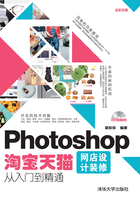
4.1 素材处理:简单抠图在店铺装修中的应用
本节主要介绍通过运用“反向”命令、“色彩范围”命令、矩形选框工具、椭圆选框工具、多边形套索工具以及魔棒工具对网店商品的抠图操作进行讲解。
4.1.1 使用“反向”命令处理商品素材
在处理单一背景的商品素材图像时,用户可以先选取背景,然后通过“反向”命令来抠取商品图像,这样可以更便捷、快速地抠取商品,为网店卖家节省时间。
下面介绍通过“反向”命令抠取商品图像的具体操作方法。

步骤 01按Ctrl+O组合键,打开商品图像素材,如图4-1所示。

图4-1 打开素材图像
步骤 02选取工具箱中的魔棒工具,在工具属性栏中设置“容差”为32,如图4-2所示。

图4-2 设置容差
步骤 03在白色背景位置单击鼠标左键,创建选区,如图4-3所示。

图4-3 创建选区
步骤 04在菜单栏中选择“选择”|“反向”命令,如图4-4所示。

图4-4 选择“反向”命令
步骤 05执行上述操作后即可反选选区,如图4-5所示。

图4-5 反选选区
步骤 06按Ctrl+J组合键,得到“图层1”图层,单击“背景”图层的“指示图层可见性”图标 ,即可隐藏“背景”图层,效果如图4-6所示。
,即可隐藏“背景”图层,效果如图4-6所示。

图4-6 最终效果
4.1.2 使用“色彩范围”命令处理商品素材
网店卖家在处理商品图像时,若商品复杂不好抠取,则可通过“色彩范围”命令利用图像中的颜色变化关系来抠取商品图像。
下面介绍通过“色彩范围”命令抠取商品图像的具体操作方法。

步骤 01按Ctrl+O组合键,打开商品图像素材,如图4-7所示。

图4-7 打开素材图像
步骤 02在菜单栏中选择“选择”|“色彩范围”命令,如图4-8所示。

图4-8 选择“色彩范围”命令
步骤 03执行上述操作后,即可弹出“色彩范围”对话框,设置“颜色容差”为80,选中“选择范围”单选按钮,如图4-9所示。

图4-9 设置参数
步骤 04将鼠标指针移至商品图像空白处并单击鼠标左键,单击“确定”按钮,即可选中空白区域,效果如图4-10所示。

图4-10 选中空白区域
步骤 05在菜单栏中选择“选择”|“反向”命令,如图4-11所示。

图4-11 选择“反向”命令
步骤 06执行上述操作后,即可反向选择商品图像,效果如图4-12所示。

图4-12 反选商品图像
步骤 07按Ctrl+J组合键,得到“图层1”图层,单击“背景”图层的“指示图层可见性”图标 ,如图4-13所示。
,如图4-13所示。

图4-13 单击“指示图层可见性”图标
步骤 08执行上述操作后,即可隐藏“背景”图层,效果如图4-14所示。

图4-14 最终效果
4.1.3 使用矩形选框工具处理商品素材
网店卖家在编辑图像时,若商品图像是矩形形状,就可通过矩形选框工具快速抠取商品图像。
下面介绍通过矩形选框工具抠取商品图像的具体操作方法。

步骤 01按Ctrl+O组合键,打开商品图像素材,如图4-15所示。

图4-15 打开素材图像
步骤 02在工具箱中选取矩形选框工具,如图4-16所示。

图4-16 选取矩形选框工具
步骤 03选择矩形选框工具属性栏后,其工具属性栏如图4-17所示。

图4-17 矩形选框工具属性栏
步骤 04执行上述操作后,将鼠标指针移动至图像编辑窗口,在合适位置按住鼠标左键并拖曳至合适位置后释放,即可创建选区,如图4-18所示。

图4-18 创建选区
步骤 05按Ctrl+J组合键,得到“图层1”图层,单击“背景”图层的“指示图层可见性”图标 ,即可隐藏“背景”图层,效果如图4-19所示。
,即可隐藏“背景”图层,效果如图4-19所示。

图4-19 最终效果
4.1.4 使用椭圆选框工具处理商品素材
网店卖家在编辑图像时,若商品图像是椭圆或圆形形状,就可通过椭圆选框工具快速抠取商品图像。
下面介绍通过椭圆选框工具抠取商品图像的具体操作方法。

步骤 01按Ctrl+O组合键,打开商品图像素材,如图4-20所示。

图4-20 打开素材图像
步骤 02在工具箱中选取椭圆选框工具,在图像适当位置按住鼠标左键并拖曳鼠标创建一个椭圆选区,如图4-21所示。

图4-21 创建椭圆选区
步骤 03移动鼠标指针至椭圆选区内,当光标呈 时拖曳鼠标,如图4-22所示。
时拖曳鼠标,如图4-22所示。

图4-22 拖曳鼠标
步骤 04移动选区至合适位置,如图4-23所示。

图4-23 移至合适位置
步骤 05按Ctrl+J组合键,得到“图层1”图层,单击“背景”图层的“指示图层可见性”图标 ,如图4-24所示。
,如图4-24所示。

图4-24 单击“指示图层可见性”图标
步骤 06执行上述操作后,即可隐藏“背景”图层,效果如图4-25所示。

图4-25 最终效果
4.1.5 使用多边形套索工具处理商品素材
在网店卖家美化商品图像时,若商品图像边缘轮廓呈直线,则可使用多边形套索工具。多边形套索工具可以创建直边的选区,其优点是只需要单击就可以选取边界规则的图像,并在两点之间以直线连接。
下面介绍通过多边形套索工具抠取商品图像的具体操作方法。

步骤 01按Ctrl+O组合键,打开商品图像素材,如图4-26所示。

图4-26 打开素材图像
步骤 02选取工具箱中的多边形套索工具,如图4-27所示。

图4-27 选取多边形套索工具
步骤 03将鼠标指针移至图像编辑窗口中的合适位置,单击鼠标左键指定起点,并在转角处单击鼠标,指定第二点,如图4-28所示。

图4-28 指定点
步骤 04用同样的方法,沿商品图像边缘依次单击其他点,最后再在起始点处单击鼠标左键即可创建选区,如图4-29所示。

图4-29 创建选区
步骤 05按Ctrl+J组合键,得到“图层1”图层,单击“背景”图层的“指示图层可见性”图标 ,如图4-30所示。
,如图4-30所示。

图4-30 单击“指示图层可见性”图标
步骤 06执行上述操作后,即可隐藏“背景”图层,效果如图4-31所示。

图4-31 最终效果
4.1.6 使用魔棒工具处理商品图像
在网店设计过程中,运用魔棒工具可以创建与图像颜色相近或相同像素的选区,在颜色相近的图像上单击鼠标左键,即可选取图像上相近的颜色范围。
下面介绍通过魔棒工具抠取商品图像的具体操作方法。

??步骤01 按Ctrl+O组合键,打开商品图像素材,如图4-32所示。步骤02 选取工具箱中的魔棒工具,如图4-33所示。

图4-32 打开素材图像

图4-33 选取魔棒工具
步骤 03在工具箱中选取魔棒工具后,其工具属性栏如图4-34所示。

图4-34 魔棒工具属性栏
步骤 04在工具属性栏上设置“容差”为32,在合适位置单击鼠标左键,即可创建选区,如图4-35所示。

图4-35 创建选区
步骤 05按Ctrl+J组合键,拷贝一个新图层,并且隐藏“背景”图层,效果如图4-36所示。

图4-36 最终效果